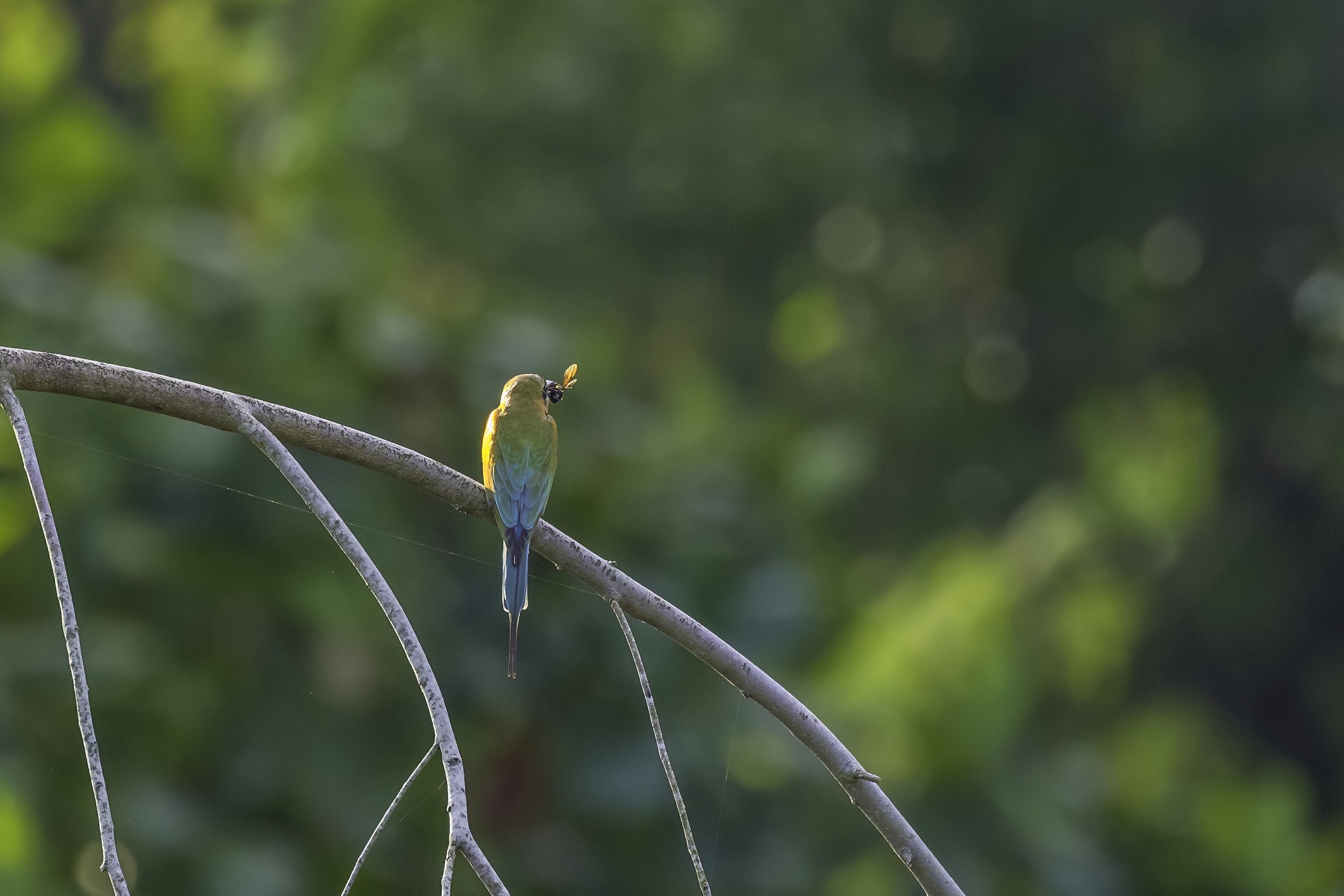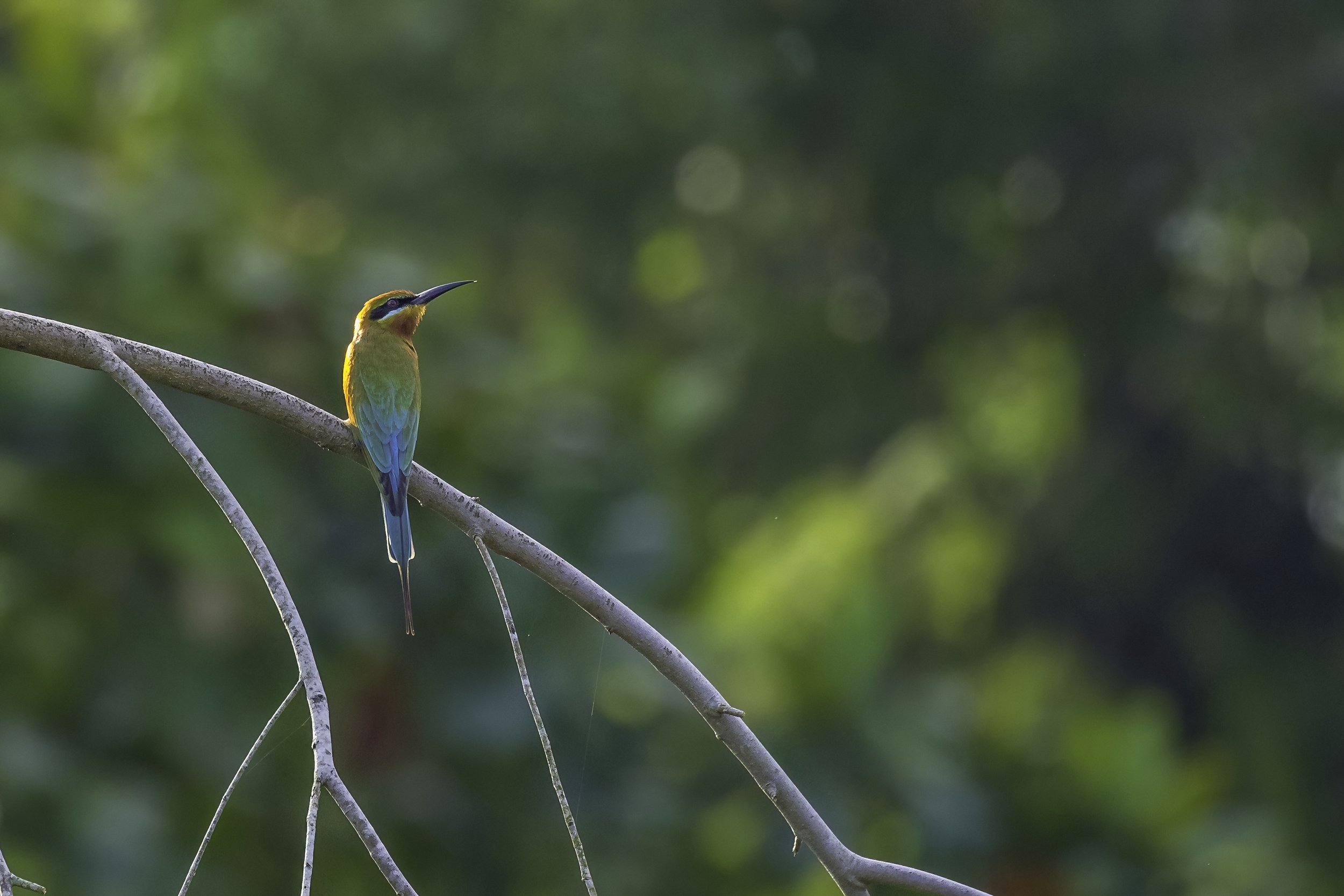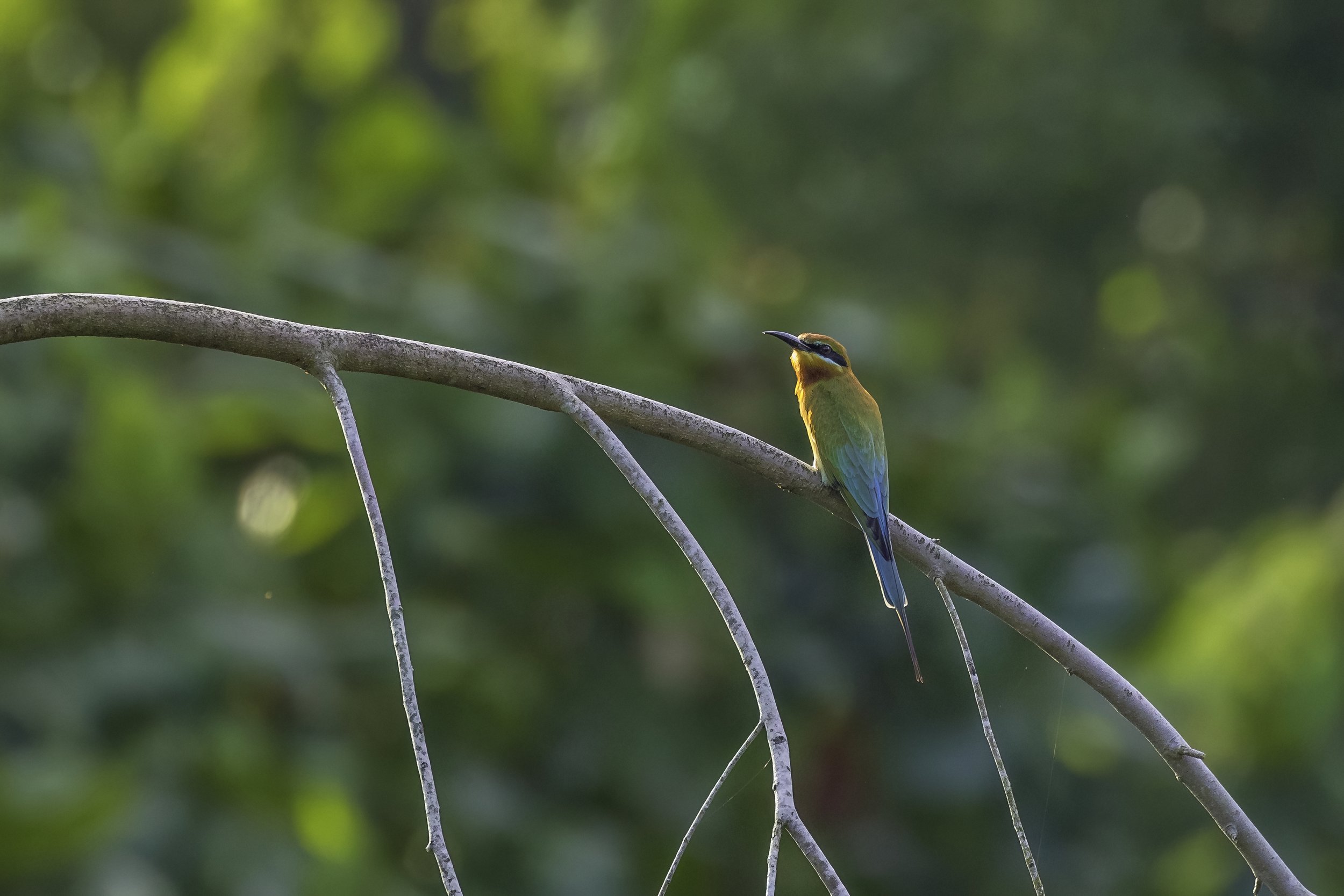Blue-tailed Bee-eater
Merops philippinus
Ammavaripeta Cheruvu, Manjeera WLS Telangana & other lakes and the Lorong Halus Wetlands, Singapore
Renowned for its extensive natural resources, breathtaking scenery, and rich cultural legacy Telangana is the eleventh largest state in India situated on the south-central stretch of the Indian peninsula on the high Deccan Plateau. It is the twelfth-most populated state in India with a geographical area of 112,077 km² of which 21,214 km² is forest cover. The dry deciduous forests ecoregion of the central Deccan Plateau covers much of the state, including Hyderabad. The characteristic vegetation is woodlands of Hardwickia binata and Albizia amara. Over 80% of the original forest cover has been cleared for agriculture, timber harvesting, or cattle grazing, but large blocks of forest can be found in the Nagarjuna Sagar - Srisailam Tiger Reserve and elsewhere. The more humid Eastern Highlands moist deciduous forests cover the Eastern Ghats in the eastern part of the state. The Central Deccan forests have an upper canopy at 15–25 meters, and an understory at 10–15 meters, with little undergrowth.
The dry sub-humid zone or Dichanthium-cenchrus-lasitrrus type of grasslands are prevalent here and cover almost the entirety of peninsular India except the Nilgiris. One sees thorny bushes like the Acacia catechu or Khair as it is known in Hindi, Mimosa, Zizyphus (Ber) and sometimes the fleshy Euphorbia, along with low trees of Anogeissus letifolia or Axle Wood, Soymida febrifuga - the Indian Redwood - and other deciduous species. Sehima (grass) which is more prevalent on gravel is about 27% of the cover and Dichanthium(grass) which flourishes on level soil is almost 80% of the coverage.
Telangana's extensive network of lakes, which enhance the state's scenic appeal and serve a vital role in delivering water for irrigation, home usage, and industrial reasons, is one of the state's most notable natural characteristics. Telangana has lakes due to its geography and the copious amounts of rain that fall there during the monsoons. Telangana is home to some of India's most stunning and ecologically significant water features, with over 6,000 natural and man-made lakes. Endowed with a rich natural resource base and a diverse environment, there are many lakes in the area, both natural and man-made, which are significant water supplies for industry, domestic use, and irrigation. The lakes of Telangana are a crucial component of the area's ecosystem and provide a habitat for many different plant and animal species. Many of the state's numerous lakes, which range in size and depth and provide visitors with breathtaking views and leisure activities like boating, fishing, and bird watching, are well-liked tourist destinations. Telangana's lakes visually represent the state's natural beauty and ecological diversity, from the picturesque Hussain Sagar Lake in Hyderabad to the tranquil Pakhal Lake in the Warangal district.
Today I am at the Ammavaripeta Cheruvu, a small lake some kilometers away from the ancient city of Warangal. Today the small lake has garnered attention for having an unusual visitor - the Spur-winged Lapwing. There are many such location across Telangana which are home to migrants and seasonal visitors and every experience of seeing a new bird provides a rush that one can only feel by doing something they love. As I mentioned in an earlier blog, bird and wildlife watching is a great form of recreation for people of all ages and always provides an opportunity to learn something new.
I have also seen the blue-tailed bee-eater at the Ameenpur Lake and some other lakes around Hyderabad and at the Lorong Halus Wetlands in Singapore.
Ammavaripeta Cheruvu
Today I am at the Ammavaripeta Cheruvu, a small lake some kilometers away from the ancient city of Warangal. The lake is in the precincts of the village of the same name falling in the Hanamkonda Mandal in the Warangal district. A peaceful village, its claim to fame is the Sammakka Saralamma Jatara, a tribal Hindu festival to honour the tribal goddesses. Held every two years to honour the goddesses Sammakka and her daughter Sarakka (also called Saralamma), it is the time for the largest tribal congregation in the world with approximately 10 million people converging on the site over a period of 4 days. The devout offer Bellam (jaggery), locally called Bangaram (gold), to the deities. The jatra begins at the remote village of Medaram in Tadvai Mandala in the Mulugu district, deep in the Etunagaram Wildlife Sanctuary, one of the oldest sanctuaries of Telangana, and a part of Daṇḍakāraṇya - the largest surviving forest belt in the Deccan and mentioned in the epic Rāmāyaṇa. All rituals to the goddesses are performed by the priests of the forest dwelling Koya Tribe (Koitur in Koya Bhasha) in accordance with their customs and traditions. This intangible cultural heritage of Telangana is believed to attract the largest number of devotees in the country after the Kumbha Mela.
There are many legends about the miraculous powers of Sammakka. According to a 13th-century tribal legend, some tribal leaders on a hunt found a newborn girl (Sammakka) enveloped in light playing amidst tigers. They took her to the tribal chief, who adopted and raised her as a leader. She later became the saviour of the tribals in the region. She was married to Pagididda Raju, the tribal chief of the Koyas. Medaram was ruled by the Kakatiyas from their capital in Warangal between 1000-1323 AD. Sammakka had two daughters and one son, Sarakka alias Saralamma, Nagulamma, and Jampanna. King Prataprudra of the Kakatiyas imposed taxes on the Koya Tribe, which they could not pay. As a result, King Prataprudra declared war on the Koya Tribe. Pagididda Raju was killed in the ensuing battle forcing the grief-stricken Sammakka to pick up the fight with her daughter Saralamma, her son Jampanna, and her son-in-law Govinda Raju. Sammakka had almost won when Saralamma died in the battle. Jampanna was mortally wounded and fell bleeding into Sampangi vaagu (stream). Legend has it that the stream, a tributary of the mighty Godavari, turned red from the blood, and the stream was renamed "Jampanna Vaagu" in honour of Jampanna's sacrifice. Distraught, Sammakka retired to a hill called Chilakala Gutta and turned into a turmeric jar (kumkuma bharani) filled with kumkuma powder. After the battle, Sammakka and Saralamma were deified and a festival or jatra was organised in their honour once every 2 years. To this day, the Koya tribe and devotees believe that Sammakka and Saralamma are manifestations of Adi Parashakti (the Supreme Goddess in Hinduism - Mahadevi as the Mulaprakriti (Primordial Goddess) is described having five primary forms—Durga, Lakshmi, Saraswati, Gayatri and Radha) sent to protect them. The jatra is a celebration to honour their sacrifice. The kumkuma jar is brought to Medaram and people wash themselves in Jampanna Vaagu, followed by an offering of Bellam or jaggery to Sammakka and Saralamma.
Several communities in Telangana society support the jatra as it is a “mythical” narrative of two tribal women leaders who rebelled against the Kakatiya rulers trying to annex their land and forests. Legend states it was Sammakka’s curse which eventually caused the gradual decline and eventual demise of the Kakatiya dynasty.
Today the small lake has garnered attention for having an unusual visitor - the Spur-winged Lapwing. There are many such location across Telangana which are home to migrants and seasonal visitors and every experience of seeing a new bird provides a rush that one can only feel by doing something they love. As I mentioned in an earlier blog, bird and wildlife watching is a great form of recreation for people of all ages and always provides an opportunity to learn something new.
Lorong Halus Wetlands
Announced in 2007, the Lorong Halus Wetland was transformed from the former landfill site as part of the Public Utilities Board’s Active, Beautiful, Clean Waters programme and officially opened on 5 March 2011. Costing some S$47.7 million, Singapore’s first manmade wetland protects the adjacent Serangoon Reservoir’s water quality by collecting and purifying the water leaching from the dump in shallow earth basins before discharging it into the sewage system.
The wetland, which is known to support a wide range of biodiversity, was adopted by NSS in 2011 and aircraft engine firm Pratt & Whitney in 2014. Neighbouring secondary schools have also developed a learning trail for the wetland. Connected to the Punggol Promenade via a pedestrian bridge, the Lorong Halus Wetlands became linked to three other parks when the 26-kilometre North Eastern Riverine Loop was completed in 2012. Plans to expand the loop were announced in 2015.
Blue-tailed Bee-eater
The Blue-tailed Bee-eater (Merops philippinus) is a near passerine bird in the bee-eater family Meropidae. It is widely distributed across South and Southeast Asia where many populations are strongly migratory, and seen seasonally in many parts but breeding colonially in small areas across their range, mostly in river valleys, where they nest by tunnelling into loamy sand banks. They are seen mostly in open habitats close to water.
It is an elegant, slender bird of open country, frequently seen in flight or perched on exposed snags or telephone wires. The adults are green overall, with a blue tail, thin black mask, and a rufous throat with bright rufous underwings visible in flight. The juveniles are similar but paler, with a tannish throat and shorter tail, lacking the adult's elongated central tail feathers. Flyings blue-tailed bee-eaters have a distinctive shape, with broad, sharply pointed wings, a long tail, and a long bill. They nest colonially in sandbanks and they voice a sweet, clipped “cheer-it”, sometimes given in series.
Blue-tailed Bee-eater - Range, Distribution & Migration
This species, like other bee-eaters, is a richly coloured, slender bird. It is predominantly green with a narrow blue patch on its face with a black eye stripe, and a yellow & brown throat, with a blue tail and black beak. The three outer toes are united around their bases. The bird can reach a length of 23–26 cm, including the two elongated central tail feathers which can be just two inches more than the remaining ten feathers. The sexes are alike and this species is usually found near water and like other bee-eaters it predominantly eats flying insects, especially bees (as large as the Xylocopa), wasps and hornets, which are caught in the air by sorties from an open perch. They may also forage in flight over estuaries, backwaters and even over the sea but not far from the coast. This species probably takes bees and dragonflies in roughly equal numbers. The insects that are caught are beaten on the perch to kill and break the exoskeleton. This habit is seen in many other members of the order Coraciiformes. They call mainly in flight with a rolling chirping whistling teerp.
The only confusable species within its range is the blue-cheeked bee-eater which however tends to be found in drier areas. The blue-tailed differs in having the rump and tail blue rather than green and black. The undertail feathers are bluish rather than green in the blue-cheeked. The blue cheek patch is much smaller while the chestnut on the throat and breast darker and covering a larger area.
Blue-tailed Bee-eater - Migration Map
Source: BirdCount.in
They breed in April to May in India nesting colonially with closely placed nest holes in a vertical mudbank or even burrowing into gently sloping land. They tend to choose sandy and sandy clay loams but avoid heavier clay loams. They also prefer clear mud banks without any vegetation cover. In Sri Lanka, they have been noted to breed in artificial sand dunes created by dredging of sea sand. The nest tunnel can run nearly 2 metres deep. About 5 to 7 near spherical eggs are laid. Both the male and the female take care of the eggs. The parents guard the nest to prevent intraspecific brood parasitism and extra pair copulation. These birds also feed and roost communally. One or two helpers may join the breeding pair after incubation begins. Although males and females appear similar to the human eye, males tend to have longer central tail feather extensions and UV reflectance studies demonstrate that healthy males had darker chestnut throats and brighter green body plumage while females showed brighter blue rumps and yellow chins.
The species has a patchy breeding distribution across India, Myanmar, and parts of Southeast Asia. In India they are known to breed in several of the river valleys including those of the Godavari, Kaveri, Tungabhadra and Krishna rivers. They also nest in the eastern parts of Sri Lanka.
Blue-tailed bee-eaters are seasonal in many parts of their range and are known to migrate diurnally en masse at some places like Tanjung Tuan (W. Malaysia) and Promsri Hill (southern Thailand). They are winter visitors in parts of Malaysia and peninsular India. The non-breeding ranges of the blue-cheeked bee-eater and blue-tailed overlap in some parts of Gujarat and western peninsular India.
‡‡‡‡‡
Related Posts





























